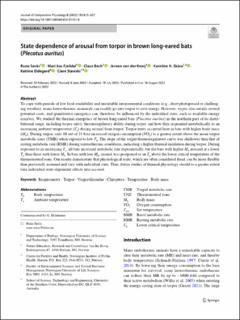| dc.contributor.author | Sørås, Rune | |
| dc.contributor.author | Fjelldal, Mari Aas | |
| dc.contributor.author | Bech, Claus | |
| dc.contributor.author | van der Kooij, Jeroen | |
| dc.contributor.author | Skåra, Karoline Hansen | |
| dc.contributor.author | Eldegard, Katrine | |
| dc.contributor.author | Stawski, Clare | |
| dc.date.accessioned | 2023-02-20T19:36:55Z | |
| dc.date.available | 2023-02-20T19:36:55Z | |
| dc.date.created | 2022-08-16T09:33:26Z | |
| dc.date.issued | 2022 | |
| dc.identifier.citation | Journal of Comparative Physiology. B, Biochemical, Systemic, and Environmental Physiology. 2022, 192 815-827. | en_US |
| dc.identifier.issn | 0174-1578 | |
| dc.identifier.uri | https://hdl.handle.net/11250/3052485 | |
| dc.description.abstract | To cope with periods of low food availability and unsuitable environmental conditions (e.g., short photoperiod or challenging weather), many heterothermic mammals can readily go into torpor to save energy. However, torpor also entails several potential costs, and quantitative energetics can, therefore, be influenced by the individual state, such as available energy reserves. We studied the thermal energetics of brown long-eared bats (Plecotus auritus) in the northern part of its distributional range, including torpor entry, thermoregulatory ability during torpor and how they responded metabolically to an increasing ambient temperature (Ta) during arousal from torpor. Torpor entry occurred later in bats with higher body mass (Mb). During torpor, only 10 out of 21 bats increased oxygen consumption (V̇O2) to a greater extent above the mean torpor metabolic rates (TMR) when exposed to low Ta. The slope of the torpid thermoregulatory curve was shallower than that of resting metabolic rate (RMR) during normothermic conditions, indicating a higher thermal insulation during torpor. During exposure to an increasing Ta, all bats increased metabolic rate exponentially, but the bats with higher Mb aroused at a lower Ta than those with lower Mb. In bats with low Mb, arousal was postponed to an Ta above the lower critical temperature of the thermoneutral zone. Our results demonstrate that physiological traits, which are often considered fixed, can be more flexible than previously assumed and vary with individual state. Thus, future studies of thermal physiology should to a greater extent take individual state-dependent effects into account. | en_US |
| dc.language.iso | eng | en_US |
| dc.publisher | Springer Nature | en_US |
| dc.rights | Navngivelse 4.0 Internasjonal | * |
| dc.rights.uri | http://creativecommons.org/licenses/by/4.0/deed.no | * |
| dc.title | State dependence of arousal from torpor in brown long-eared bats (Plecotus auritus) | en_US |
| dc.title.alternative | State dependence of arousal from torpor in brown long-eared bats (<i>Plecotus auritus</i>) | en_US |
| dc.title.alternative | State dependence of arousal from torpor in brown long-eared bats (Plecotus auritus) | en_US |
| dc.type | Peer reviewed | en_US |
| dc.type | Journal article | en_US |
| dc.description.version | publishedVersion | en_US |
| dc.source.pagenumber | 815-827 | en_US |
| dc.source.volume | 192 | en_US |
| dc.source.journal | Journal of Comparative Physiology. B, Biochemical, Systemic, and Environmental Physiology | en_US |
| dc.identifier.doi | 10.1007/s00360-022-01451-8 | |
| dc.identifier.cristin | 2043273 | |
| cristin.ispublished | true | |
| cristin.fulltext | original | |
| cristin.qualitycode | 1 | |

